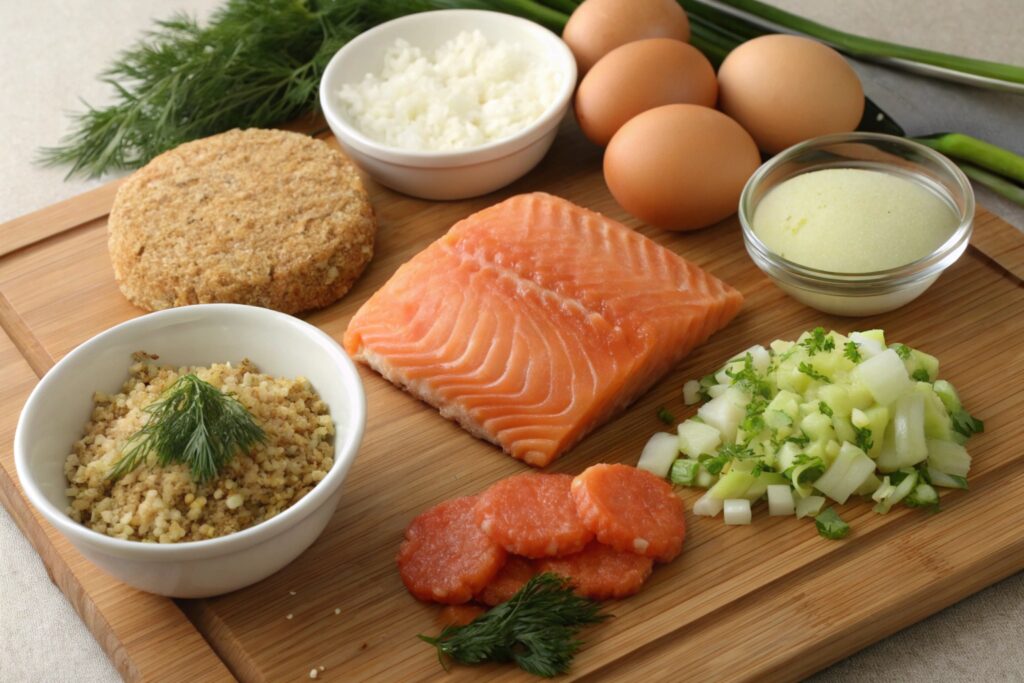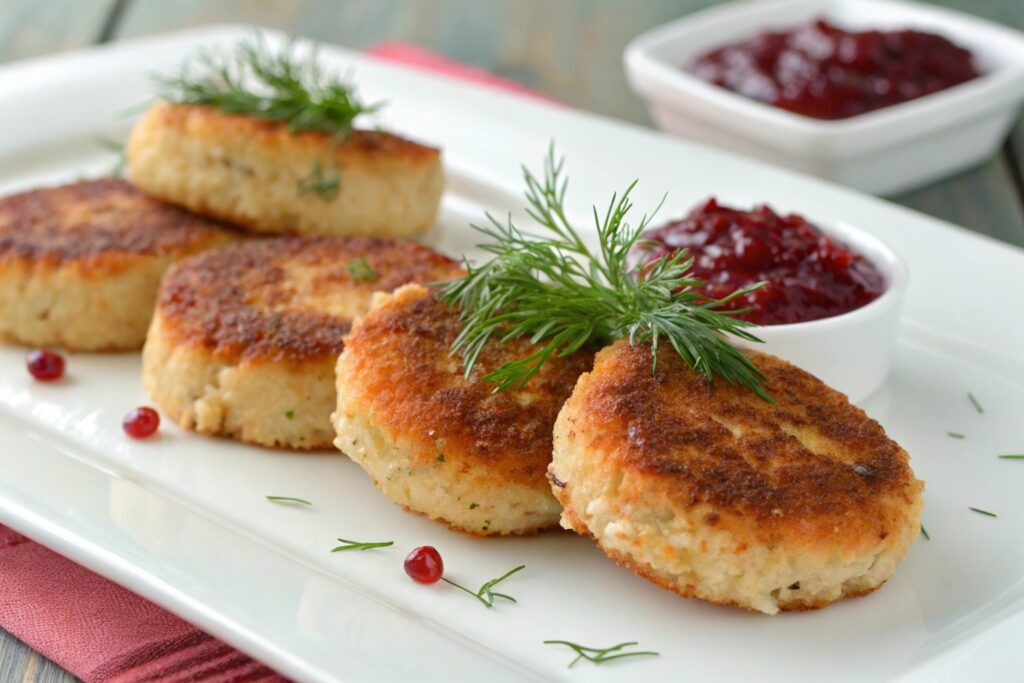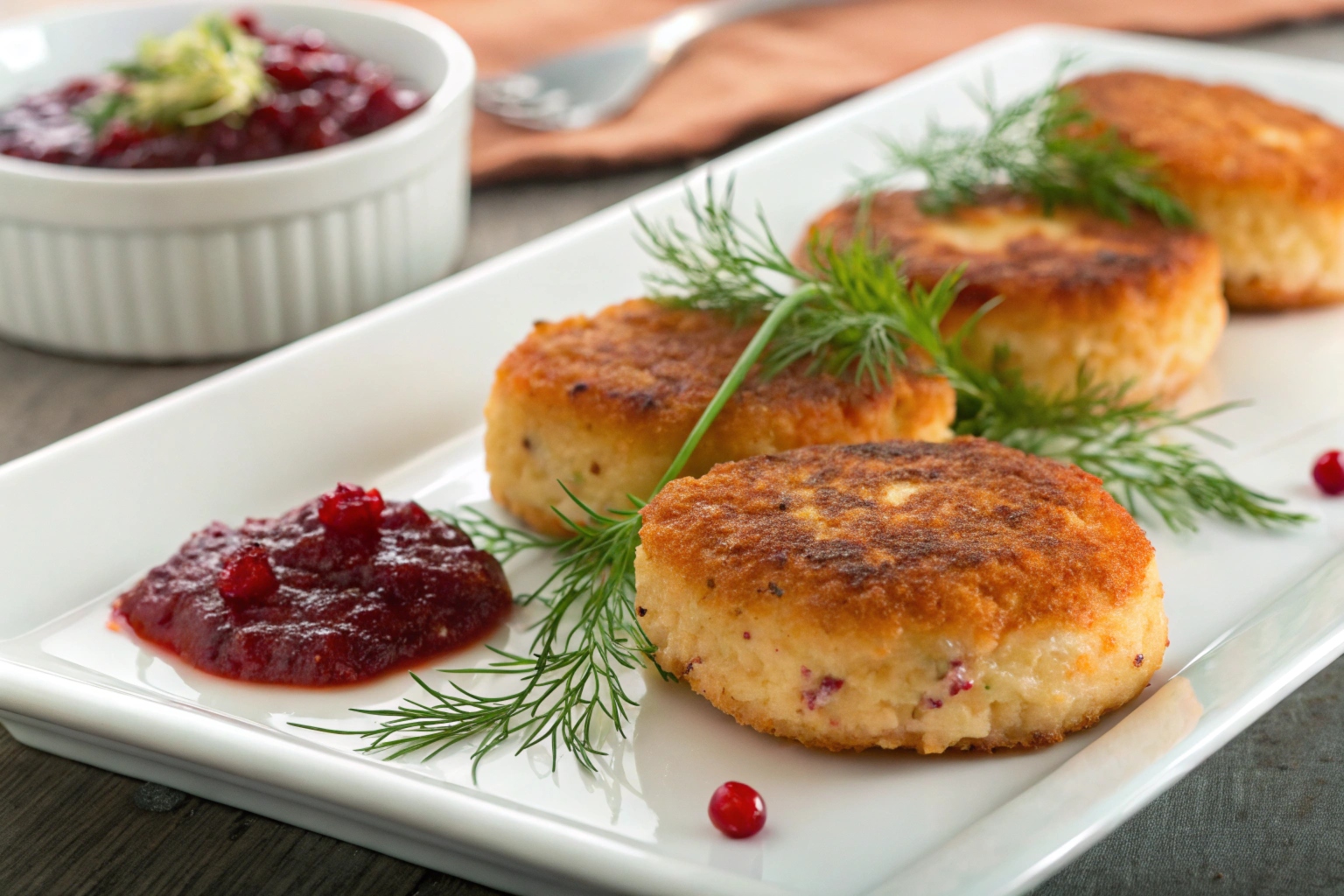Salmon cakes are a culinary delight that combines simplicity, flavor, and versatility. Whether you’re hosting a dinner party or preparing a quick family meal, salmon cakes offer a satisfying solution. Their crispy texture, savory flavor, and adaptability to various ingredients make them a favorite in households worldwide. This salmon cakes recipe guide takes you through every step of creating the perfect salmon cakes, from selecting the right type of salmon to mastering the cooking methods for golden brown perfection. Along the way, you’ll discover tips, variations, and side dishes to elevate your salmon cakes to a gourmet level.
Essential Ingredients for Salmon Cakes

The key to great salmon cakes lies in using simple ingredients that pack a punch of flavor. Understanding each component’s role in the recipe ensures your salmon cakes turn out perfect every time. Here are the essentials:
- Salmon: Fresh or canned salmon forms the base of the recipe. Fresh salmon offers a rich and firm texture, while canned salmon is convenient and budget-friendly.
- Binders: Ingredients like bread crumbs, almond flour, or panko bread crumbs help hold the patties together. They also add subtle texture and contribute to the overall structure.
- Seasonings: Kosher salt, black pepper, onion powder, and garlic powder provide a savory depth of flavor. Balancing these ensures the cakes are well-seasoned without overpowering the salmon’s natural taste.
- Moisture Add-ins: Lemon juice, mayonnaise, or unsalted butter add moisture to the salmon mixture, preventing the cakes from drying out during cooking.
- Aromatics: Green onion and yellow onion bring a fresh, mild flavor that complements the richness of the salmon.
- Optional Enhancements: Capers, hot sauce, or lemon zest can be added for a burst of flavor. These ingredients allow for customization based on personal preference.
For those with dietary restrictions, gluten-free options like almond flour or cornmeal work seamlessly as substitutes for traditional bread crumbs. Having your ingredients measured and ready before starting the recipe will save time and ensure a smooth cooking process.
Types of Salmon to Use: Fresh vs. Canned
Choosing between fresh and canned salmon depends on your preferences, budget, and time constraints. Here’s a closer look at the pros and cons of each:
Fresh Salmon
- Pros: Fresh salmon, such as wild-caught Alaskan Sockeye Salmon, provides a richer flavor and firmer texture. The freshness enhances the overall taste and creates a more robust dish.
- Cons: It requires more preparation, including cooking and flaking. Fresh salmon can also be more expensive, especially if sourced out of season.
When using fresh salmon, look for bright, firm fillets with a clean scent. Avoid fillets with a dull appearance or overly fishy smell.
Canned Salmon
- Pros: Canned salmon is pre-cooked, making it incredibly convenient. It’s also more affordable and has a long shelf life, making it a pantry staple.
- Cons: It may lack the depth of flavor found in fresh salmon and can have a softer, less flaky texture.
Tip: For the best of both worlds, try combining fresh and canned salmon in your recipe. This approach adds flavor complexity and saves time.
Step-by-Step Guide to Making Salmon Cakes
Creating salmon cakes from scratch is a rewarding process. Follow these detailed steps to ensure flawless results.
1. Preparing the Salmon
Preparation varies depending on whether you use fresh or canned salmon.
- Fresh Salmon: Start by cooking the fillet. Heat a nonstick skillet over medium-high heat and place the fillet skin-side down. Cook for 5-7 minutes, or until the flesh is opaque and flakes easily with a fork. Allow it to cool before removing the skin and flaking the meat into small pieces.
- Canned Salmon: Drain the salmon thoroughly to remove excess liquid. Check for and remove any bones or skin. Use a fork to break the salmon into flakes, ensuring an even texture throughout the mixture.
2. Mixing Ingredients for the Patty
Combine the flaked salmon with your binders, seasonings, and aromatics in a large mixing bowl. A typical mixture includes:
- 1 cup bread crumbs or almond flour
- 2 tablespoons olive oil
- 1/2 teaspoon garlic powder and paprika
- 1 tablespoon lemon juice
- 1/4 cup diced green onions
Mix gently to avoid overworking the ingredients. The goal is to create a cohesive salmon mixture that holds together when pressed but remains slightly flaky.
3. Forming the Patties
Divide the mixture into equal portions. Using a 4-tablespoon ice cream scoop is an effective way to ensure consistency.
- Roll each portion into a ball, then flatten it into a patty about 2-3 inches in diameter.
- For larger batches, consider forming patties in advance and storing them on a baking sheet lined with parchment paper until ready to cook.
4. Cooking Methods: Baking, Frying, and Grilling
Each cooking method offers unique benefits, allowing you to choose based on your preferences and available equipment.
- Baking: Preheat your oven to 375°F. Arrange the patties on a parchment-lined baking sheet and bake for 12-15 minutes, flipping halfway through.
- Frying: Heat a nonstick skillet with olive oil over medium heat. Cook the patties in batches, frying each side for 3-4 minutes until golden brown and crispy.
- Grilling: Brush the patties with oil to prevent sticking. Grill over medium-high heat for 5-6 minutes per side, achieving a slightly smoky flavor.
Tips for Achieving the Perfect Texture

Achieving the ideal texture is key to making delicious salmon cakes. Here are some tips:
- Use parchment paper to prevent sticking when baking and for easier cleanup.
- For an extra crispy texture, fry the patties in a mixture of unsalted butter and olive oil.
- Avoid overmixing the salmon mixture, as this can lead to dense, less flaky cakes.
- Let the patties rest for 10-15 minutes before cooking to help them hold their shape.
Flavor Variations and Ingredient Substitutions
Salmon cakes are incredibly versatile, and you can easily adapt the recipe to suit your tastes. Consider these variations:
- Spicy Twist: Add 1/2 teaspoon cayenne pepper or a dash of hot sauce to the mixture.
- Herbaceous Flavor: Incorporate fresh dill, parsley, or cilantro.
- Substitutes: Replace bread crumbs with cracker crumbs, cornmeal, or gluten-free panko for different textures and dietary needs.
Recommended Side Dishes to Serve with Salmon Cakes
The right side dishes elevate salmon cakes into a complete meal. Here are some popular pairings:
- Green Salad: A fresh salad with mixed greens, cucumbers (like Pickled Cucumber Salad), and a creamy dressing complements the richness of the salmon cakes.
- Green Beans: Sautéed green beans with garlic and olive oil provide a flavorful and nutritious accompaniment.
- Remoulade Sauce: This tangy, slightly spicy sauce is perfect for dipping and adds an extra layer of flavor.
For a heartier option, serve the salmon cakes with roasted potatoes or a side of steamed rice.
Storing Leftovers: Best Practices
Leftover salmon cakes can be just as delicious as freshly made ones if stored properly. Here’s how:
- Refrigeration: Place cooked patties in an airtight container and refrigerate for up to 3 days.
- Freezing: Wrap uncooked patties individually in plastic wrap and store them in a freezer-safe bag. They’ll keep for up to 3 months.
- Reheating: Reheat cooked patties in a nonstick skillet over medium-low heat to restore their crispy texture without drying them out.
Nutritional Information for Salmon Cakes
Salmon cakes are a nutritious choice, offering high protein and essential nutrients:
- Protein: Salmon is an excellent source of protein, promoting muscle repair and growth.
- Omega-3 Fatty Acids: These healthy fats support brain function and heart health.
- Vitamins: Rich in vitamin D and B12, salmon cakes are a great addition to a balanced diet.
Calorie counts vary based on ingredients, but a standard salmon cake contains approximately 200 calories.
Video Tutorials for Varying Techniques
For visual learners, video tutorials can make the process even easier. Consider searching for:
- Tutorials on shaping uniform patties using a 4-tablespoon scoop.
- Step-by-step guides for frying salmon cakes to achieve a golden brown crust.
- Gluten-free preparation methods, showcasing substitutions like almond flour.
Reader Variations: Personal Touches and Modifications
Salmon cakes are endlessly customizable, and we love hearing how readers make them their own. Here are a few popular ideas:
- Using leftover salmon or steelhead trout for a sustainable twist.
- Adding ingredients like roasted red peppers or sun-dried tomatoes for a Mediterranean flair.
- Experimenting with spice blends like Old Bay seasoning or Cajun spices for a unique kick.
Conclusion
Salmon cakes are a delicious, versatile dish suitable for any occasion. By following this guide, you can create crispy, flavorful salmon cakes tailored to your tastes. Don’t forget to experiment with variations, pair them with your favorite sides, and share your creations with us! Enjoy the process and the delicious results.

